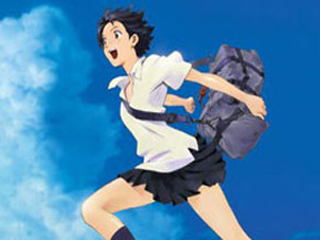
This ran at the BFI yesterday, so I took the opportunity to see the film on a big screen. For some reason they moved it to the main NFT1 screen, possibly it was doing better in ticket sales than they thought as the theatre was packed. Regardless, it was superior experience to whichever of the theatres I saw Mind Game in a couple of years ago, I wasn’t squashed up against the side of a wall. Also, unlike Mind Game, it was actually screened off a film print rather than a DVD. Unfortunately the film print had seen better days, the start of the film had a lot of noise and dirt on the print, and there were glitches here and there later in the movie. Nothing too detrimental, but a little annoying at the start.
Watching the film with a full audience reasserted in my mind that Mamoru Hosoda is the anime director that people have bemoaned is lacking – someone who can create excellent films, with broad appeal, whose surname isn’t Miyazaki. And he does it without aping the Ghibli style. Hosoda’s style is distinctly recognisable as his own. For awhile I wasn’t sure if the look of his films was his own, or that of his frequent collaborator Takaaki Yamashita, but seeing some of Yamashita’s work away from Hosoda, makes me think it’s firmly Hosoda’s vision that we see on screen.
Hosoda’s work frequently uses shots that frame the world in a way that simulates the point of view of someone standing in that world (though not a character POV). Lots of wide shots, low horizons and high skys. Often, rather than changing shots, or using tracking shots and close ups, we see a scene act out within that shot. Late in the film he plays with the idea of a tracking shot, using it as he would any of his other shots, by having a character move within the frame of the tracking shot, effectively outrunning the speed of the “camera”.
Also he takes great care in positioning characters within a shot, drawing your focus to them, even when there is a lot going on in the background. Hosoda is interested in rooting his animated world in reality, even if the story involves time travel, digital monsters or super-powered pirates, and here he gets to do that to it’s fullest extent yet. Often shots are full of bustling human life meaning that, unlike much anime, the characters don’t live in a vacuum of their own existence. And the movements of the main characters themselves aren’t some idealised, smooth version of human movement, they are clumsy, bumbling and rambunctious.
Story-wise, this is my favourite sort of science fiction, where a single idea is all that separates the fictional world from our own. It is a charming and light concoction, indeed, it is commented within the film that it’s good that the ability to time travel is used so trivially. The performances of the three leads are for the most part good, though Riisa Naka as Makoto is far better at the comedic aspects of her role than the emotional parts. Her crying really left a lot to be desired (a distressed walrus springs to mind) but there’s only really one scene that comes up in.
Easily the best animated film of 2006, it’s good that Kadokawa & Bandai have been attempting to give it the international recognition it deserves.